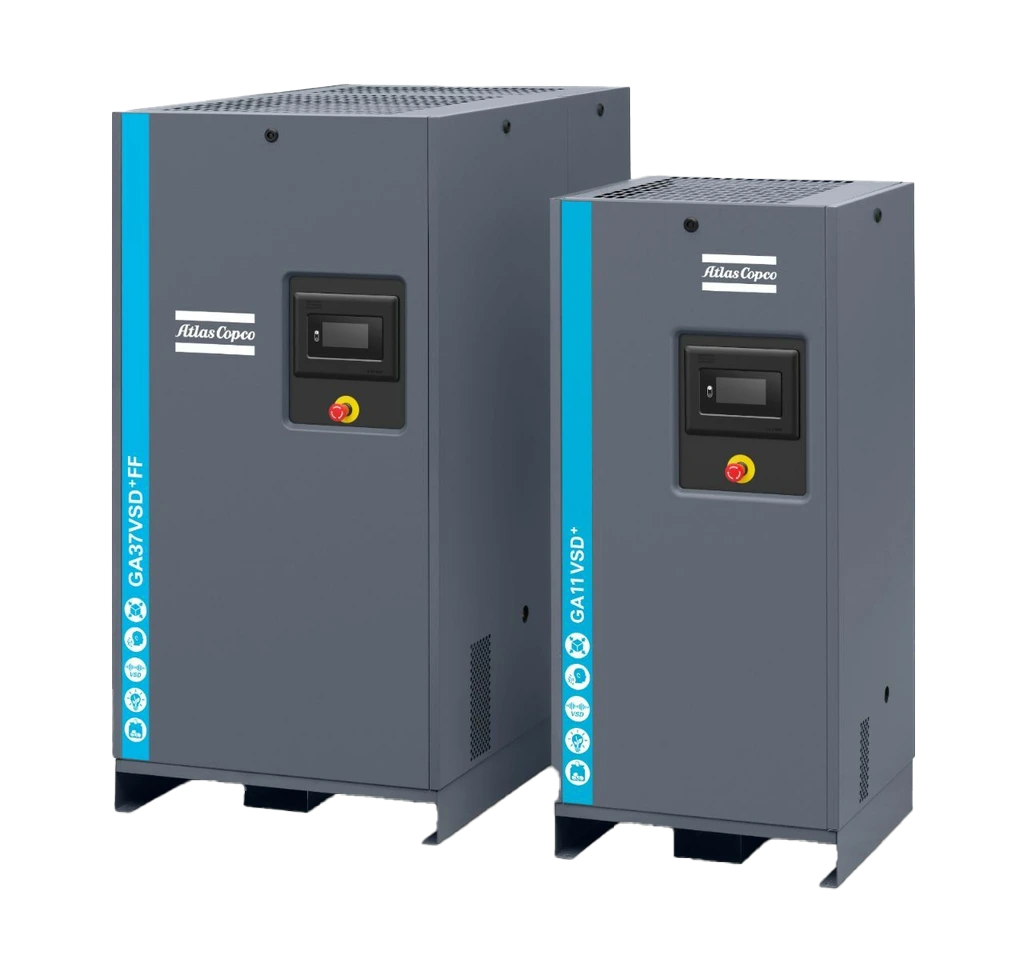
Atlas Copco Air Compressors in Scotland
As a Premier Atlas Copco distributor in the UK, based in Scotland, Design Air Scotland is proud to offer a complete range of professional-grade compressors engineered for superior performance, robust reliability, and outstanding energy efficiency.
Atlas Copco is a global leader, and its systems are designed for continuous industrial use, ensuring your operations run smoothly and cost-effectively. We are a trusted partner for the supply of compressed air to countless UK industries.
If you’re based in Scotland and need help specifying and selecting an appropriate air compressor for your application, get in touch and an expert member of our team will help guide you through this process and quote you for a suitable compressor.
Get Started with a Trusted Partner Today
Ready to find the perfect compressed air solution for your business? The team at Design Air Scotland is here to help. We offer free site assessments and energy audits to identify your exact needs and demonstrate potential savings.
Contact us today for a tailored quote, expert advice, and fast delivery of in-stock units.
Why Choose Atlas Copco from Design Air Scotland?
Atlas Copco has built a world-renowned reputation for engineering excellence and sustainable productivity. When you choose their compressors, you are investing in:
- Proven Reliability: Superior build quality and robust components ensure minimal downtime and a long service life.
- Energy Efficiency: With innovations like variable speed drive (VSD+ and the latest VSDˢ), Atlas Copco compressors can reduce energy consumption by up to 60%, directly lowering your operational costs.
- Low Total Cost of Ownership: By optimising energy use and maintenance needs, these compressors deliver the lowest overall lifecycle cost on the market.
- Advanced Technology: Integrated smart controllers such as the Elektronikon® provide real-time monitoring and operational efficiency, putting you in complete control.
- Authorised Expertise: As a trusted Atlas Copco distributor in the UK, Design Air Scotland provides expert guidance, professional compressed air installation, and dedicated after-sales support (including genuine spare parts and a fast repair service) to meet all your compressed air needs.
Atlas Copco Air Compressors From Design Air Scotland
Lowest Total Cost of Ownership
As you will likely keep your new Air Compressor for at least 7–10 years, around 80–90% of your total lifecycle costs cost of ownership in this period will be in electrical energy.
Atlas Copco industrial Air Compressors are extremely efficient, reliable and typically have the lowest total cost of ownership when factoring in initial purchase price, electrical running costs and maintenance costs.
By investing a little more upfront in one of the many Atlas Copco’s Premium Efficiency Air Compressors from Design Air Scotland, you will likely spend significantly less over the lifespan of the equipment.
Air Compressor Financing and Rental Options
At Design Air Scotland, we are flexible to meet your payment requirements. We appreciate that purchasing an Atlas Copco Air Compressor is a long-term investment, so we can help you finance your purchase over 3–60 months. We also offer short-term rental and long-term lease options for seasonal demands, temporary projects, or emergency use.
Instead of waiting for a return on your investment, make a saving immediately. We can demonstrate that your monthly payments will be lower than the electrical cost savings your new compressor will provide.
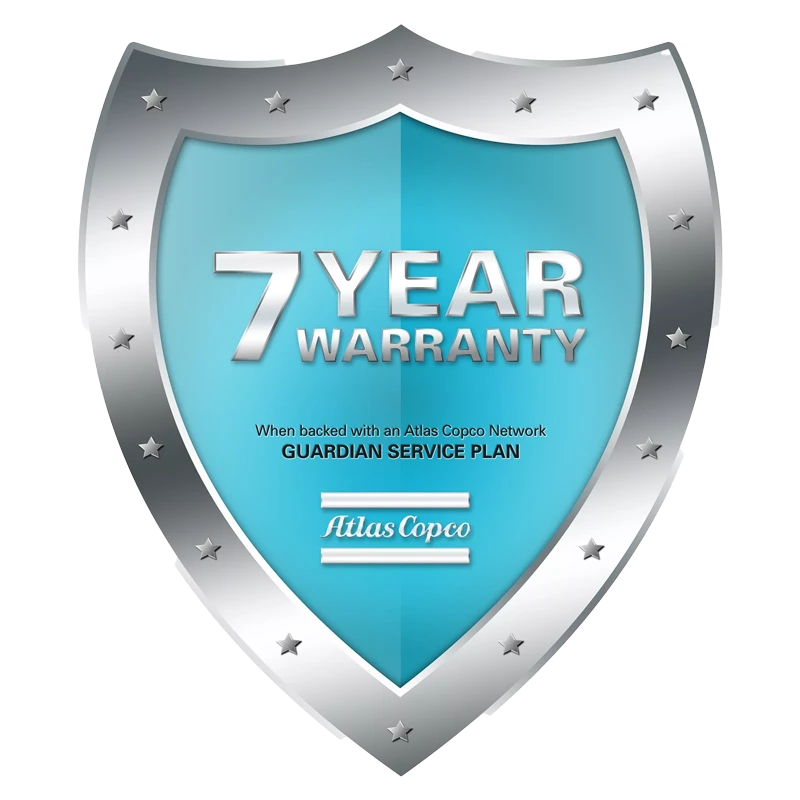
7-Year Air Compressor Warranty and Servicing
As Premier Atlas Copco Distributors, if you agree to a Guardian service plan with Design Air Scotland, your new Air Compressor will come complete with a 7-year warranty depending on your budget.
We are confident that our Guardian Service Plan, which uses only official Atlas Copco compressor parts, will ensure your new air compressor continues to run reliably and efficiently. However, if it does not, you will not pay a penny for the repair.
This plan enables you to accurately budget for your maintenance costs throughout the air compressor’s lifespan. Our certified local technicians also provide preventative maintenance and emergency repairs to keep your system at peak performance.
Air Compressor options to suit all budgets
As market leaders in the air compressor industry, Atlas Copco offers compressors to suit all budgets. Regardless of whether you have a strict budget and need to minimise initial up front expenditure, or if you are looking for the most premium, energy efficient compressor on the market, we can provide you with an air compressor that will suit your requirements and budget.
Regardless of how much you spend, at Design Air Scotland we’re confident that your new Atlas Copco Compressor will give you trouble free running over its lifespan.
We also offer extended payment terms and financing options to suit your business needs. This means you can get the air compressor you need whilst keeping cashflow healthy. If you need to buy air compressors, our team can find the right solution.
Remote Monitoring of Your Air Compressor
If you purchase an Atlas Copco Compressor from Design Air Scotland, the unit will come with an in-built SMART Box or Elektronikon® controller (subject to model).
This box allows you and us to remotely access your compressor’s running parameters from any web browser via SMARTLINK connectivity.
This, in turn, allows us to accurately plan when service work is due and diagnose any issues before sending an engineer to a breakdown. It also enables us to proactively take action on any warnings that may arise before they cause the compressor to trip.
As such, at Design Air Scotland, we can ensure that your compressor remains in pristine condition.
Air Compressors you can rely on
Atlas Copco have got an unparalleled reputation for producing solid and reliable air compressors. This is for good reason. Each compressor utilises Atlas Copco’s state of the art compression element and is constructed to the highest standards utilising high quality materials. As a result, these compressors can withstand the harshest of environments and running conditions. As long as the compressor is correctly serviced and operated within it’s limitations, the performance of the compressor is guaranteed for up to 7 years.
By choosing an Atlas Copco Air Compressor from Design Air Scotland, you are choosing a compressor that is built to last the test of time.
Our Range of Atlas Copco Air Compressors
We offer a wide variety of compressors available to suit any application or budget.
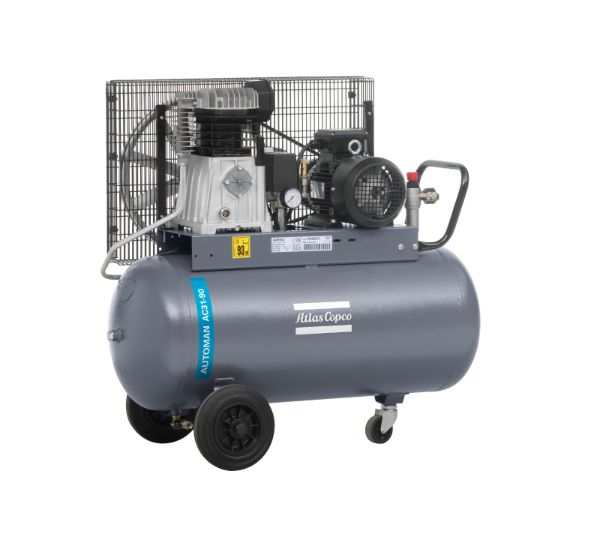
Piston Air Compressors
- A durable and cost-effective solution for workshops, garages, and applications with intermittent air demand.
- Key Features: built for longevity and easy maintenance, suitable for high-pressure applications. Available in both oil-lubricated and oil-free versions.
- Main Motor Size Range: 0.5 - 15 kW
- Free Air Delivery Range: 2 - 67 cfm
- Max Working Pressure Range: 10 - 30 bar(g)
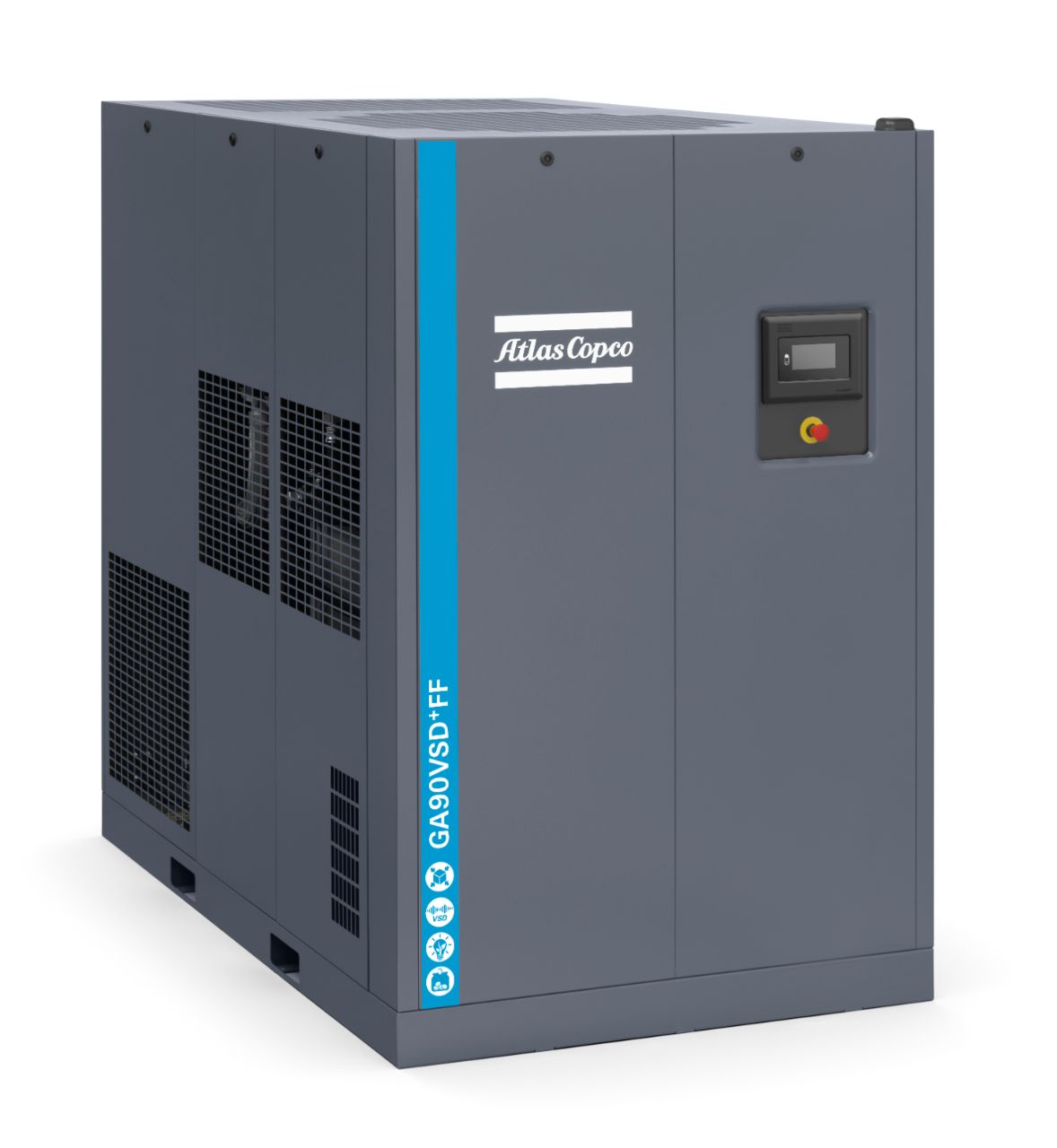
Oil-Injected Rotary Screw Compressors
- Ideal for demanding 24/7 industrial use, the GA, G, and VSD+ series are the workhorses of modern manufacturing.
- Models Include: G2-G22 Series, GA Series, GA VSD+ Series
- Key Features: highly efficient oil-injected element, quiet operation, robust performance for continuous use. The VSD+ models offer market-leading energy savings. This includes the latest in screw air technology.
- Main Motor Size Range: 2 - 500 kW
- Free Air Delivery Range: 8 - 3,217 cfm
- Max Working Pressure Range: 5 - 14 bar(g)
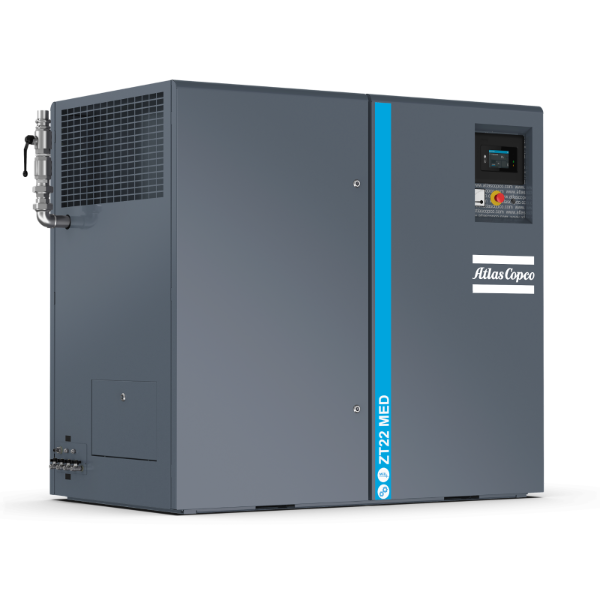
Oil Free Air Compressors
- Perfect for sensitive industries such as food and beverage, pharmaceuticals, and electronics, where air purity is non-negotiable. These units are certified Class 0 (ISO 8573-1), guaranteeing 100% oil-free air.
- Models Include: Z-series (ZR/ZT) oil-free rotary screw, SF scroll compressors
- Key Features: eliminates the risk of product contamination and ensures compliance with strict health and safety standards. We provide both oil-injected and oil-free solutions.
- Main Motor Size Range: 1.5 - 55 kW
- Free Air Delivery Range: 6 - 302 cfm
- Max Working Pressure Range: 4 - 10 bar(g)
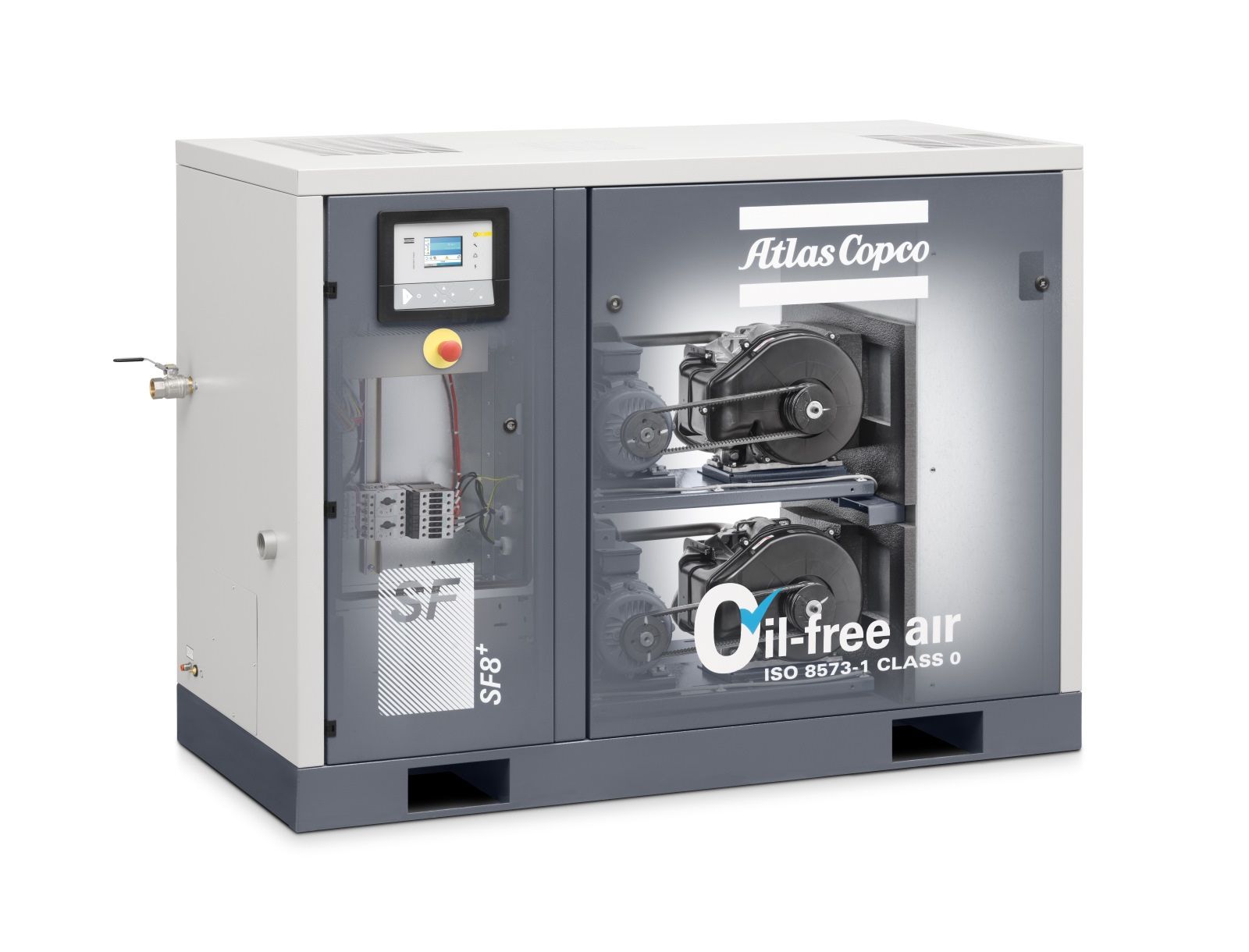
Scroll Compressors
- Key Features: Extremely quiet, vibration-free operation with a compact footprint. The ideal choice for laboratories, dental clinics, and other noise-sensitive environments.
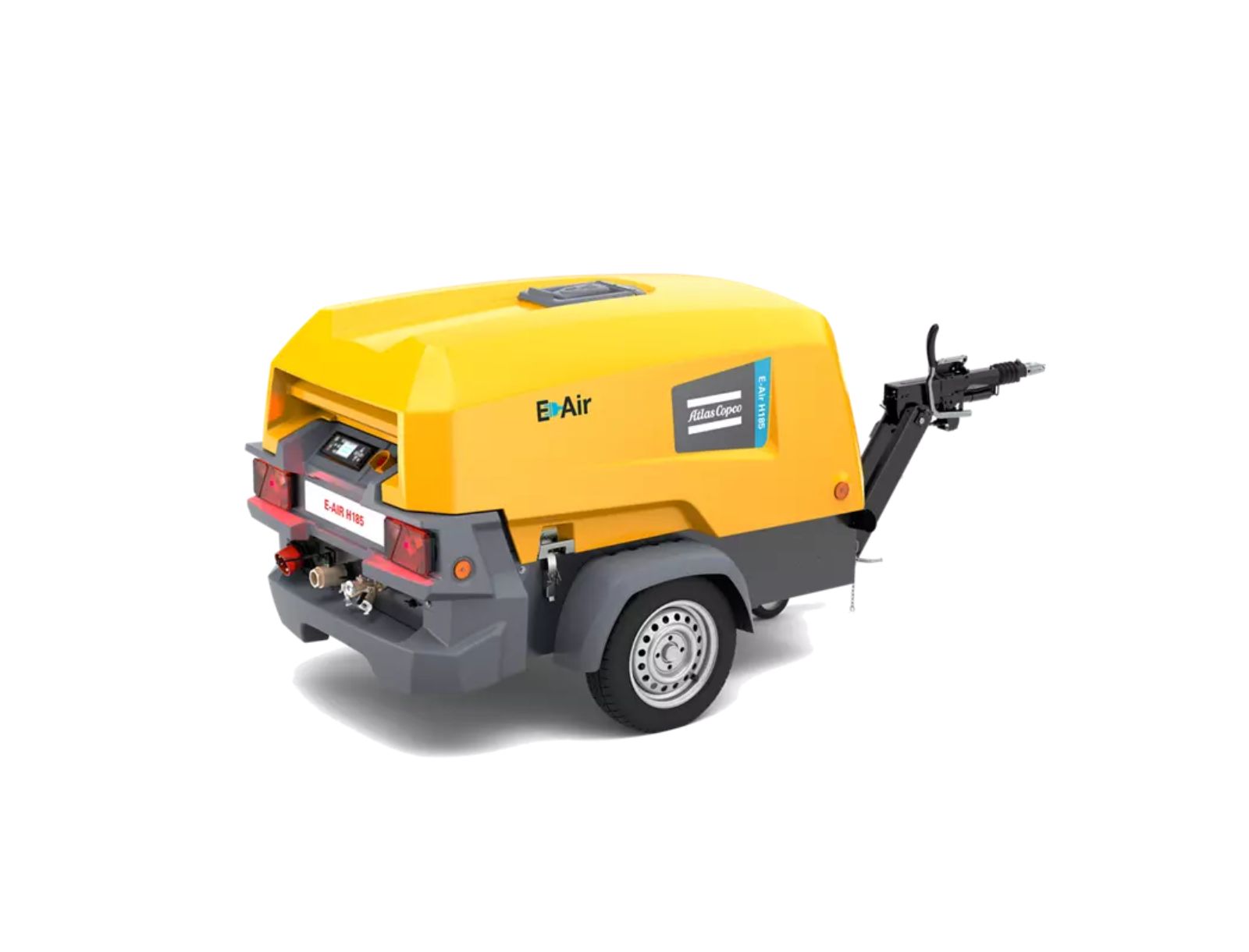
Portable Air Compressors
- Key Features: Robust, fuel-efficient mobile air power for construction sites, utility work, and remote jobs. This range is also ideal for marine and offshore applications. Designed for easy transport and reliable performance in tough conditions.
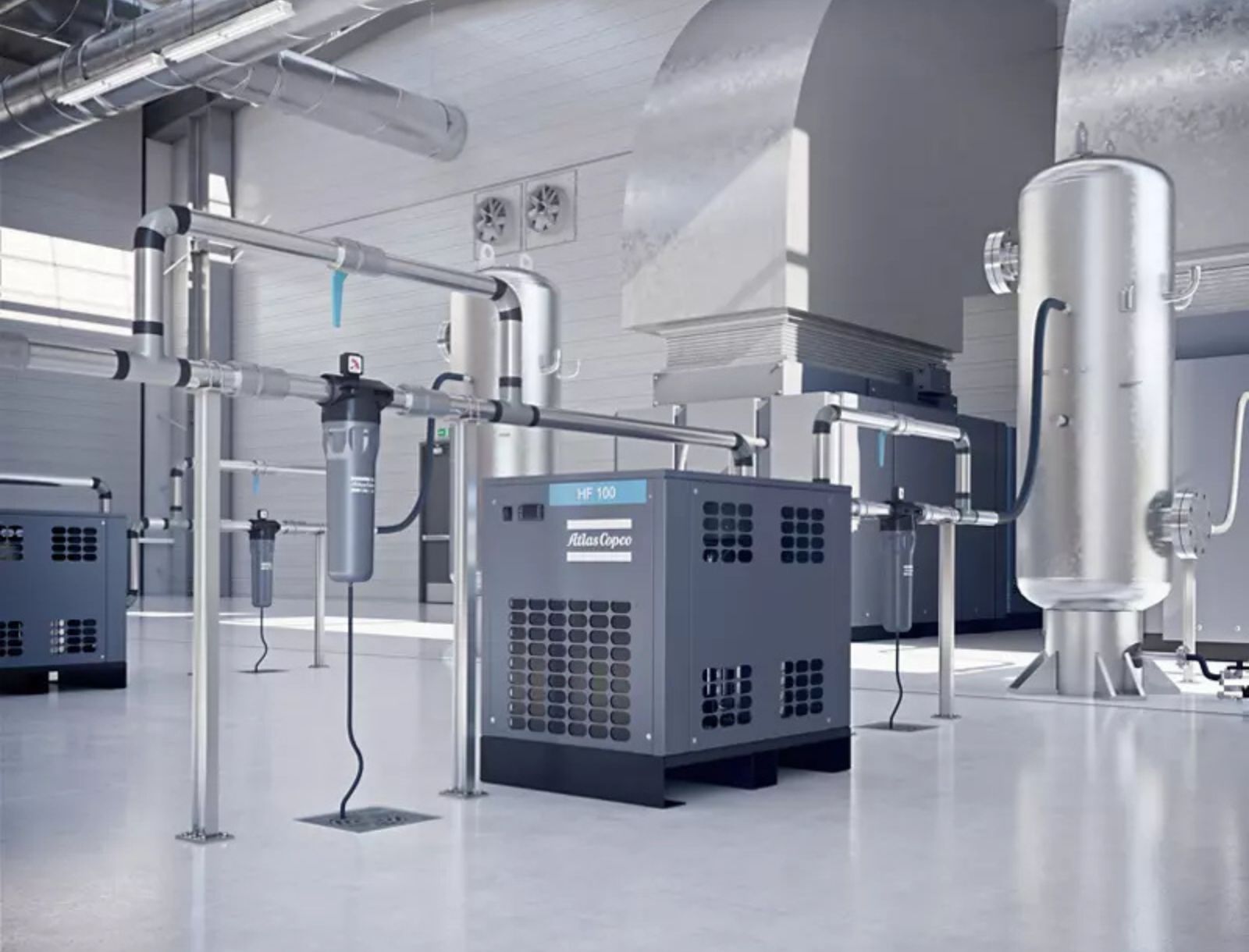
Complete Industrial Solutions
- The Atlas Copco group is a world leader in industrial equipment. Beyond compressed air solutions, their expertise is part of a broader portfolio that includes industrial gas generators for on-site production of nitrogen and oxygen, low-pressure blowers for wastewater treatment and industrial water processes, as well as vacuum pumps, process chillers, and equipment for power generation. Whether you need a simple pump or a complex industrial gas system, we can help specify the right solution.
Your Partner for UK Compliance & Safety
Operating industrial compressed air systems in the UK requires strict adherence to safety regulations. As your expert partner, Design Air Scotland helps you navigate these legal requirements to ensure your site is safe and compliant.
- Pressure Systems Safety Regulations 2000 (PSSR): We are qualified to provide and manage your Written Scheme of Examination (WSE) to comply with PSSR, ensuring your pressure systems are inspected and maintained correctly.
- Provision and Use of Work Equipment Regulations 1998 (PUWER): We ensure your equipment is installed and serviced to meet HSE standards for safe operation.
Our expertise ensures your installation is not only efficient but fully compliant with UK health and safety legislation.
How Atlas Copco Technology Compares
While Atlas Copco offers a market-leading range, we also service and have deep expertise in other major brands. Here’s a brief comparison of their key technologies:
- Atlas Copco vs. Ingersoll Rand: Atlas Copco is a pioneer in VSD technology, particularly with the latest VSDˢ generation, often leading in pure energy efficiency. Ingersoll Rand is renowned for its exceptional durability and robust R-Series compressors. We service and supply parts for both.
- Atlas Copco vs. Kaeser & CompAir: Kaeser is known for its Sigma Profile rotors and a strong focus on system efficiency. Atlas Copco competes with its advanced SMARTLINK remote diagnostics and industry-leading Class 0 oil-free technology. We can provide unbiased advice on the best TCO for your specific application.
Air Compressor FAQs?
An air compressor is a mechanical device that converts power, usually from an electric motor or a petrol/diesel engine, into compressed air. It works by drawing in atmospheric air, compressing it, and then storing the air for various uses.
- Compression Chamber: The compressed air is typically contained within a compression chamber. The pressure of the air rises significantly as it gets compressed. This increase in pressure can be at a much higher pressure than the atmospheric air it started as.
- Outlet Valve: Once the air reaches the desired pressure, it is released through an outlet valve. The outlet valve can be adjusted to control the pressure of the compressed air.
- Regulator (Optional): A regulator can be used to control the pressure of the compressed air as it leaves the tank or the compressor. This allows users to adjust the pressure to match their specific needs.
- Outlet: Any moisture or impurities in the compressed air may be removed through filters and separators. Compressed air may also be cooled to reduce moisture content before it is used in some applications.
Different types of air compressors, including reciprocating (piston), rotary screw, and centrifugal compressors, achieve compression using varying mechanisms. Each type has its advantages and is suited for different applications based on factors such as capacity, pressure requirements, and efficiency.
Air compressors have a wide range of applications across various industries and sectors, including:
- Manufacturing: for power pneumatic tools, actuators, and material handling.
- Automotive: powering impact wrenches, paint sprayers, and tyre inflation.
- Construction and Demolition: operating pneumatic hammers, jackhammers, and nail guns.
- Food and Beverage: providing Class 0 oil-free air for packaging, processing, and cleaning
- Pharmaceuticals and Healthcare: for medical devices, dental drills, and cleanroom processes.
- Aerospace and Electronics: in pneumatic control systems and contamination-free manufacturing.
- Energy Production: for combustion air supply and pneumatic controls in power plants.
The versatility and reliability of air compressors make them indispensable in a wide range of industries and everyday applications. The specific type and size of air compressor used can vary based on the intended application and air pressure requirements.
The average compressed air consumption for various range of pneumatic tools can vary widely based on factors such as the tool’s design, size, and intended application. Additionally, the pressure at which the compressed air is supplied to the tools will also affect their air consumption rates. Below are approximate average air consumption rates for some common pneumatic tools at a typical operating pressure of 90 pounds per square inch (psi) or 6.2 bar:
- Impact Wrench:
- 1/2-inch drive: 4-8 CFM (cubic feet per minute)
- 3/4-inch drive: 8-12 CFM
- Air Ratchet:
- 3/8-inch drive: 3-4 CFM
- 1/2-inch drive: 5-6 CFM
- Air Drill:
- 3/8-inch chuck: 3-6 CFM
- 1/2-inch chuck: 4-8 CFM
- Die Grinder:
- 1/4-inch collet: 4-6 CFM
- 1/8-inch collet: 2-4 CFM
- Air Grinder (4-inch): 7-8 CFM
- Air Sander (Dual-Action): 10-12 CFM
- Paint Spray Gun (HVLP): 7-12 CFM
- Nail Gun (Framing): 2-4 CFM
- Nail Gun (Finish/Brad): 0.3-2 CFM
- Air Hammer (Chisel): 3-11 CFM
- Blow Gun: 3-8 CFM
- Air Vacuum: 8-12 CFM
These figures are approximate and can vary based on the specific brand, model, and usage conditions of the tools. It’s important to note that some tools, like air sanders, may have variable air consumption rates depending on the task at hand. Tools with adjustable speed or torque settings may also have varying air consumption rates based on the selected setting.
When selecting an air compressor for your tools, it is crucial to consider the cumulative air consumption of all the tools you plan to use simultaneously, as well as their required duty cycle (how often they run). The compressor should be sized to meet or exceed the total air demand to ensure proper operation. It is also worth adding approximately 10–20% to this figure to account for leaks that may develop over time. Using a compressor that is too small may lead to insufficient air supply, resulting in low pressure and reduced tool performance. Conversely, using a larger compressor can provide more versatility and accommodate a wider range of tools, but is likely consume more energy and cost more to run.
Compressor FAD stands for “Free Air Delivery.” It is a term used to describe the actual volume of compressed air that a compressor can deliver to its downstream system or tools at a specific set of operating conditions.
FAD is a term used to describe the actual volume of compressed air that a compressor can deliver to its downstream system or tools at a specific set of operating conditions. FAD is an important specification for evaluating the performance of an air compressor, as it indicates the amount of usable compressed air the compressor can provide for your specific applications.
FAD takes into account factors such as pressure, temperature, and humidity and is typically expressed in units like cubic feet per minute (CFM) or litres per minute (LPM).
- Pressure: FAD is typically measured at a specific discharge pressure, which is often stated in psi (pounds per square inch) or bar. The pressure at which FAD is measured may vary from one compressor manufacturer to another, so it’s important to check the specific conditions under which FAD is reported.
- Temperature: The temperature of the compressed air can affect its volume. FAD is often measured at a standardized temperature, such as 68°F (20°C), to provide a consistent basis for comparison.
- Humidity: FAD assumes that the compressed air is dry and free from moisture. Moisture in the air can reduce the effective FAD because the compressor may need to work harder to remove moisture from the air.
FAD is typically expressed in units like cubic feet per minute (CFM) or liters per minute (LPM) and represents the flow rate of compressed air as if it were at atmospheric conditions (usually at sea level) and at a specific temperature and pressure. This value helps users understand how much compressed air they can expect to receive from a compressor for their various tools and applications.
It is important to note that the FAD value may be lower than the displacement or theoretical capacity of the compressor, as real-world compressors experience losses due to factors like heat generation, mechanical inefficiencies, and pressure drop in the system. Therefore, when selecting an air compressor for specific applications, it’s crucial to consider not only the FAD but also the operating conditions and any additional factors that may affect its performance.
Screw compressors and piston (reciprocating) compressors are two common types of air compressors, each with its own set of advantages and disadvantages. Here are some of the advantages of screw compressors over piston compressors:
- Continuous Operation: Screw compressors provide continuous and pulsation-free airflow, making them suitable for applications where a consistent air supply is crucial. Piston compressors produce pulsating airflow, which may require additional equipment (such as an air receiver) to smoothen the flow.
- Higher Capacity: Screw compressors generally offer higher capacity and airflow rates than piston compressors of similar size. They are well-suited for industrial applications with higher air demand.
- Quiet Operation: Screw compressors are quieter than piston compressors, which can be important in applications where noise levels need to be kept to a minimum.
- Compact Design: Screw compressors are typically more compact than piston compressors with similar capacity, making them suitable for installations with limited space.
- Durability: Screw compressors are designed for continuous operation and can handle heavy-duty industrial use, making them reliable for demanding applications.
- Cooler Operation: Screw compressors tend to operate at lower temperatures than reciprocating compressors, which can help extend the life of compressor components and reduce the risk of overheating.
While screw compressors offer many advantages, it’s important to note that they may have a higher initial purchase cost compared to piston compressors. The choice between the two types of compressors should be based on the specific needs of your application, including factors like air demand, required air quality, available space, and budget constraints. If you are still unsure, please contact us at Design Air (Scotland) for some expert advice.
The choice between a fixed-speed compressor and a Variable Speed Drive (VSD) compressor depends on various factors related to your specific compressed air system requirements and usage. Here are some key considerations to help you decide which type of compressor is more suitable for your needs:
1. Air Demand Profile:
- Fixed-Speed Compressor: If your air demand remains relatively constant and predictable throughout the day, a fixed-speed compressor can be a cost-effective choice. Fixed-speed compressors operate at a consistent speed and are suitable for applications with steady air demand.
- VSD Compressor: VSD compressors are ideal for applications with variable or fluctuating air demand. They can adjust their speed to match the required output, which can lead to significant energy savings during periods of lower demand. If your compressed air demand varies throughout the day or between shifts, a VSD compressor can be more efficient.
2. Energy Efficiency:
- Fixed-Speed Compressor: Fixed-speed compressors typically operate at full capacity when running, and they may cycle on and off to maintain the desired pressure. This can result in energy inefficiencies during unloaded conditions.
- VSD Compressor: VSD compressors are known for their energy efficiency, especially at partial load conditions. By varying their speed, they can closely match air output to demand, reducing energy consumption and operating costs.
3. System Flexibility and Pressure Control:
- Fixed-Speed Compressor: If your application requires a consistent and fixed air pressure, a fixed-speed compressor with a regulated outlet can provide stable pressure, but the compressor outlet pressure will typically cycle between two pressure set points within a pressure band of approx 0.5-2bar
- VSD Compressor: VSD compressors offer greater flexibility and adaptability, responding to changing demand in real time. They can also maintain a much tighter and more stable system pressure. VSD compressors can also maintain stable pressure but have the advantage of operating within a smaller pressure band of approx 0.2bar. This can allow you to target a much lower operating pressure thus reduce energy costs.
4. System Flexibility:
- Fixed-Speed Compressor: Fixed-speed compressors are generally straightforward to operate and maintain. They are well-suited for applications with consistent air demand.
- VSD Compressor: VSD compressors offer greater flexibility and adaptability. They can respond to changing demand in real-time, providing optimal performance and efficiency.
5. Cost Considerations:
- Initial Cost: VSD compressors typically have a higher upfront cost compared to fixed-speed compressors. However, the potential energy savings over time can offset the initial investment.
- Operating Cost: VSD compressors are more energy-efficient at part-load conditions, which can result in lower operating costs over the compressor’s lifespan, particularly in applications with variable air demand.
In summary, the choice between a fixed-speed compressor and a VSD compressor depends on your specific air demand patterns, energy efficiency goals, and budget. If your air demand varies significantly or you prioritise energy efficiency, a VSD compressor may be the better choice. However, for applications with stable, constant air demand, a fixed-speed compressor may provide adequate performance at a lower initial cost. It’s essential to conduct a thorough assessment of your compressed air system’s needs. For help determining which option is best for you, please contact us at Design Air (Scotland) for some expert advice.
Choosing between an oil-free and an oil-lubricated air compressor depends on your specific application. An oil-free compressor is essential if any risk of oil contamination in the air supply is unacceptable. Key industries include:
- Food and Beverage
- Pharmaceuticals and Medical
- Electronics and Semiconductor Manufacturing
- Laboratories and Clean Rooms
For general industrial applications such as manufacturing, automotive repair, and construction, where durability and heavy use are primary concerns, a more efficient and longer-lasting oil-lubricated compressor is often the better option.
Oil-Free Air Compressors
Pros:
- Cleaner Air: Oil-free compressors don’t add oil contamination to the air supply, making them ideal for applications where oil carryover is a risk that cannot be tollerated, such as food and beverage processing, pharmaceuticals, electronics and clean room environments.
- Environmentally Friendly: Since they don’t use oil, there’s no risk of oil spills or contamination, making them more environmentally friendly.
Cons:
- Shorter Lifespan: Oil-free compressors typically have a shorter lifespan compared to their oil-lubricated counterparts because they don’t benefit from the lubricating properties of oil.
- Noise Level: These compressors can be noisier, which might be a consideration for the workplace.
- Heat Management: Without oil for cooling, oil-free compressors can run hotter, which might affect performance over prolonged use periods.
- Reduced efficiency: When compared with oil lubricated compressors, oil-free compressors are typically less efficient, producing less air for the equivalent energy consumption.
Best Uses:
- Medical and Dental Applications: Where the risk of oil carryover cannot be tolerated.
- Food and Beverage Industry: To avoid contamination of products.
- Laboratories and Clean Rooms: Where any oil vapor could compromise the environment.
Oil-Lubricated Air Compressors
Pros:
- Longer Lifespan: The oil lubrication reduces wear and tear on internal components, often resulting in a longer-lasting machine.
- Quieter Operation: The oil helps dampen noise, making these compressors generally quieter.
- Better for Heavy-Duty Use: Oil-lubricated compressors are better suited for heavy-duty, continuous use, making them ideal for industrial applications.
- Efficiency and Performance: These compressors can handle larger loads and are typically more efficient for extensive use.
Cons:
- Risk of Contamination: There’s a potential risk of oil contaminating the air supply, which might not be suitable for certain applications.
Best Uses:
- Industrial Applications: Such as manufacturing, automotive repair, and construction where reliability and durability are essential.
- Professional Workshops: Where high-capacity, continuous use is common.
- High-Performance Tools: That require a consistent and powerful air supply.
Decision Factors
- Application: If your work demands oil-free air (e.g., medical, food industry), an oil-free compressor may be the best choice. For heavy-duty industrial applications, an oil-lubricated compressor is likely more appropriate.
- Maintenance and Lifetime Costs: Consider the maintenance requirements and total cost of ownership.
Conclusion
Choosing between an oil-free and oil-lubricated air compressor comes down to your specific needs and application. For clean air an oil-free compressor is ideal. However, for longevity, efficiency, quieter operation, and heavy-duty use, an oil-lubricated compressor is the better option. Assess your primary use cases and weigh the pros and cons to make the best choice for your situation.
Service intervals depend on the model and usage, but a general guideline is every 2,000 to 4,000 running hours. Your compressor’s Elektronikon® controller will alert you when service is due. We recommend a preventative maintenance plan to ensure optimal performance and reliability.



